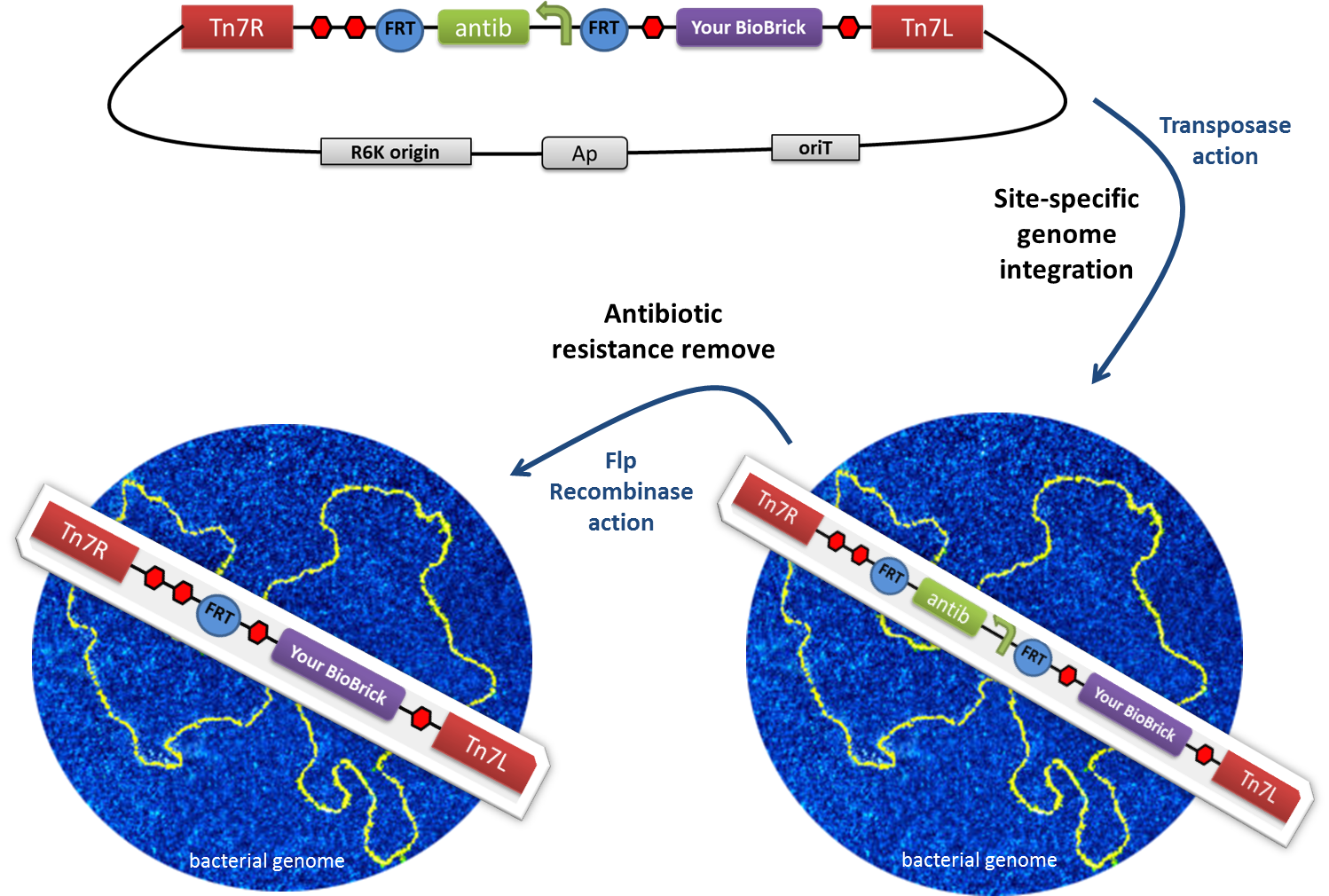Genome Integration
The parts in the [http://2011.igem.org/Team:UPO-Sevilla/Foundational_Advances/MiniTn7/Overview miniTn7 BioBrick toolkit] are based on the excellent set of miniTn7 derivatives developed by Choi et al. (2005)[http://www.nature.com/nmeth/journal/v2/n6/abs/nmeth765.html]. All our derivatives contain the Tn7-L and Tn7-R ends, an antibiotic resistance gene flanked by FRTs and the prefix/suffix BioBrick-compatible multi-cloning site. Constructs will be available in derivatives of pUC18-Sfi, (high copy number, replicative in any E. coli strain), or derivatives of pUC18-R6KT (medium copy number, replicative only in E. coli strains expressing the pir gene). Specialized miniTn7 vectors containing promoters for gene expression or reporters for expression measurement will also be constructed. In addition, we will provide a portable attTn7 (Tn7 attachment site) to allow using the miniTn7 BioBrick toolkit in any organism as well as in plasmids.
Data for our characterized new parts
- pUC18Sfi-miniTn7BB-Gm plasmid (BBa_K510000): this plasmid harbor the basic miniTn7 which may be used for integration of BioBricks in single copy into the genomes of non-enteric bacteria, in which it is non-replicative, at the conserved attTn7 site.
- pUC18R6KT-miniTn7BB-Gm plasmid (BBa_K510012): this plasmid may be used for transposition of BioBricks into the genome of any bacterium without the pir gen thanks to is R6K replication origin.
- attTn7 or Tn7 insertion site (BBa_K510022): recognition and insertion site of the Tn7 transposon and its synthetic derivatives.
We have also submitted these new parts:
- pUC18SfiI-miniTn7BB-Cm (BBa_K510001): this construct is the result of replacing the gentamycin resistance cassette in pUC18SfiI-miniTn7BB-Gm by a chloramphenicol resistance cassette obtained from pBS1C3 by PCR amplification.
- pUC18SfiI-miniTn7BB-Km (BBa_K510002): replace of the gentamycin resistance cassette of pUC18Sfi-miniTn7-Gm by a kanamycin resistance cassette amplified from pSB4K5.
- pUC18R6KT-miniTn7BB-Cm (BBa_K510013): replace of the gentamycin resistance cassette in pUC18R6KT-miniTn7BB-Gm by a chloramphenicol resistance cassette obtained from pBS1C3 by PCR amplification with these primers
- pUC18R6KT-miniTn7BB-Km (BBa_K510014): replace of the gentamycin resistance cassette in pUC18R6KT-miniTn7BB-Gm by a kanamycin resistance cassette obtained from pBS4K5.
- pUC18R6KT-miniTn7BB-Gm-RBS+RFP (BBa_K510015): This plasmid can be used for promoter characterization purposes inserting the promoter using the prefix restriction sites. Also the characterization can be performed in single copy by integrating the device in the genome of the working organism.
- pUC18R6KT-miniTn7BB-Gm-pBad/araC (BBa_K510016): This plasmid can be used as inducible expression vector in single copy by integrating the device in the genome of the working organism.
- pUC18R6KT-miniTn7BB-Gm-tetR (BBa_K510017): This plasmid can be used as inducible expression system in single copy by integrating the device in the genome of the working organism.
- pUC18R6KT-miniTn7BB-Gm-lacZ+GFP (BBa_K510018): This plasmid can be used for promoter characterization purposes inserting the promoter using the prefix restriction sites. Also the characterization can be performed in single copy by integrating the device in the genome of the working organism.
- pUC18R6KT-miniTn7BB-Gm-RFP (BBa_K510020): This plasmid can be used for visualization purposes or to brand a strain because of its insertion in the genome of the working organism and split the antibiotic resistance cassette with the temporary expression of Flp recombinase.
- pUC18R6KT-miniTn7BB-Gm-Lux (BBa_K510021): This plasmid can be used for visualization purposes or to brand a strain because of its insertion in the genome of the working organism.

|
David Caballero Pradas developed the miniTn7 BioBrick toolkit in the iGEM team UPO-Sevilla 2011[http://2011.igem.org/Team:UPO-Sevilla]. |

